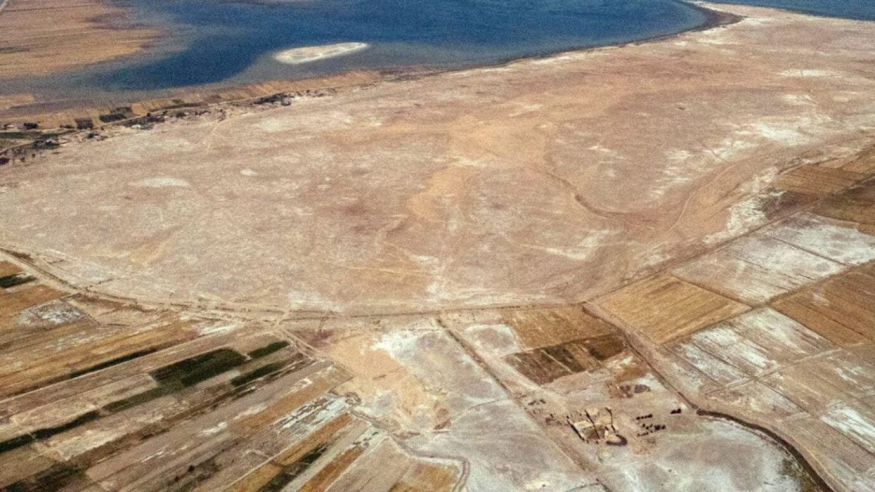A floor eye in the sky has assisted in the rehydration of a historic southern Mesopotamian metropolis, dubbed as Fertile Crescent's Venice. Determining the early metropolis' watery character offers crucial consequences according to how urban civilization evolved approximately about 5,000 years ago, seen between rivers Tigris and Euphrates wherein the area of present Iraq is centered.
According to an anthropological archaeologist, Emily Hammer of the University of Pennsylvania, remote-sensing measurements from a specially fitted drone show that somehow a big urban metropolis named Lagash has mostly been made up of four marshland islands interconnected by canals.
Such research results add important facts to a growing consensus that southern Mesopotamian states did not, as thought previously, advance approach from the temple as well as institutional districts into other irrigated croplands encircled by a single city wall, according to Hammer's statement in the December Journal of Anthropological Archaeology.
Lagash, the Metropolis in the Marshland
"As human settlement plus natural change transformed the terrain, it's possible that a variety of different ways for Lagash to be a metropolis of swamp islands," Hammer explains.
She suggests that it is because Lagash seems to have no physical or ceremonial core; each city sector established independent economic patterns on a separate marsh island, similar to the medieval Italian city of Venice. Waterways or canals, for particular, intersected one marsh peninsula where fishery and reed collecting for building might well have held sway, as reported by Globe News Insider.
The following two Lagash marsh archipelagos feature gated fortifications that surround meticulously drawn-out downtown streets and regions with big kilns, indicating that such segments were created in phases and could have been the earliest to be occupied. Crop cultivation as well as pursuits such as earthenware manufacturing might have taken place therein.
Aerial images of just what appears to port upon every marsh island imply that boat traffic is linked to metropolitan districts. Walkway ruins can be found in and along rivers separating marsh islands, a potential that future digs can pursue.
Discovering Swampy Lagash
Lagash, among the world's first states, was established approximately 4,900 to 4,600 centuries prior. Subsequent excavations suggest that inhabitants deserted the region, now recognized as Tell al-Hiba, roughly 3,600 years ago. This was discovered almost 40 years ago.
Earlier studies by anthropological archaeologist Jennifer Pournelle of the University of South Carolina of Columbia on the chronology of historical marshes developments in southern Iraq revealed that Lagash as well as other southern Mesopotamian towns originally built on elevated mounds in marshes. From satellite imagery, archaeologist Elizabeth Stone of Stony Brook University in New York theorized that Lagash was made up of around 33 marsh islands, most of which are absolutely small, according to News Live Washington.
Thus according to Hammer, aerial shots offered a much more comprehensive view of Lagash's underground buildings than satellite photos could. The drone flew 6 weeks in 2019 taking excessive images of a significant portion of the site's surface, guided by early remote-sensing information recorded from the land surface. Soil humidity and saline accumulation from previous heavy rains aided the drone's capabilities in detecting vestiges of houses, walls, roadways, canals, and some other city elements submerged at the ground surface.
Hammer added that the drone information helps her to pinpoint heavily populated areas of the historical town to three islets. It's also possible that certain islands were remnants of delta canals leading toward the Persian Gulf. A massive temple overshadowed a shorter fourth island.

Lagash Early Civilization Around The Marsh
According to University of Chicago archaeologist Augusta McMahon, one amongst three co-field supervisors of current digs at Lagash, Hammer's aerial investigation "proves the concept of populated islets linked by waterways."
She added that the diverse neighborhoods on separate marsh islands, many seemingly designed and others more randomly built, show waves of people migrating into Lagash from 4,600 and 4,350 years ago. Based on the site clearing, newcomers comprised citizens of surrounding and faraway villages, nomadic herdsmen wishing to settle down, and even slave workers were taken from the nearby downtown area.
It is uncertain if the northernmost Mesopotamian towns dated roughly 6,000 years ago, that were positioned in marshes, had independent city districts. However, according to archaeologist Guillermo Algaze of the University of California, San Diego, Lagash and some other southern Mesopotamian towns presumably took advantage of waterway transit and commerce between densely packed communities, facilitating remarkable expansion, explained in a report from Science News.
According to Hammer, Lagash stands out as an ancient southern Mesopotamian metropolis fixed in history. Nearby civilizations were occupied for a century or more after Lagash's departure, as the region became less swampy and sections of longer-lasting towns grew and united. "We have such a rare chance to examine what other historic towns in the area appeared like earlier in history," Hammer said about the Lagash.
RELATED ARTICLE: First Domesticated Hybrid Animal Are Super-Strength Donkeys That Are Faster, Stronger Than Horses
Check out more news and information on Archaeology in Science Times.










